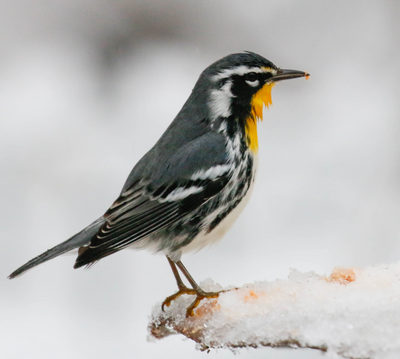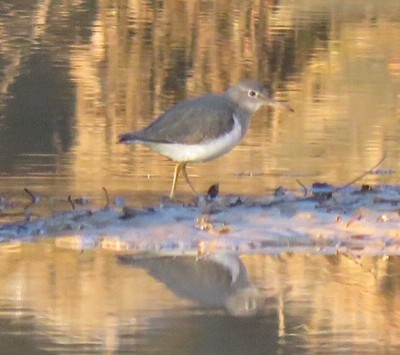2018 Chapel Hill (NC) Christmas Bird Count Summary
Rarities on the 2018 Chapel Hill CBC!

This Yellow-throated Warbler appeared for several weeks at the Driscoll's suet feeder. Photograph by Barbara taken before the count, though it did put in an appearance on count day. Amazingly, they also had a Yellow-throated on the 2009 CBC. Coincidence or same bird??

This Spotted Sandpiper was photographed by Jan Hansen at University Lake, for a second count record.
|
On the Sunday, 23 December 2018 Chapel Hill Christmas Bird Count, we had a nice day with some big surprises, including one species not recorded before in the 89 year history of the count! We got 91 species on count day, a bit above the average 88. The weather leading up to the count was wet but not too cold, so some areas, such as Mason Farm and parts of Jordan Lake, were inaccessible because of high water and we didn't get a lot of ducks from the frozen north. Count day weather was fair, though birds were relatively scarce. We counted only 10754 individual birds, the lowest in 22 years, barring the snowy 2010 count. This is nearly a third lower than the average count of 15217. Sparrows were in particularly short supply, with our lowest numbers since 1990. On a birds per party hour basis, it was an abysmal count, with 77 versus an average of 110, our lowest since 1996. Some spectacular rarities made up somewhat for the scarcity of birds overall.
New to the count this year was a White-eyed Vireo, found by Brian Bockhahn in a privet thicket at the dove fields north of Stagecoach Road. Brian managed to snap an identifiable shot of it with his iPhone, as he called it in to within 5 feet! Perhaps this was a long overdue first, as they are found in North Carolina every winter on the coastal counts. Another great find for the count was a Spotted Sandpiper at University Lake, found and photographed by Jan Hansen. This is a second for the count; our last one on the CBC was reported in 1960! A third for the count was the Great Egret found by Paul Taillie in a secluded wetland in the woods next to Little Creek, just upstream from the Pinehurst Drive golf course ponds. Derb Carter had some great finds near Maple View Farm: a Merlin, our 5th for the count, a Black-and-white Warbler (our 7th), and an Orange-crowned Warbler (our 8th). To complete the run, Tom and Barbara Driscoll had our 6th Yellow-throated Warbler in their yard, well photographed. Other goodies included 2 Northern Shovelers (Bockhahn), 9 Bufflehead (Carter and the team of Shelley Theye and Jill Froning), a Northern Bobwhite, (Bockhahn), Common Yellowthroat (Haven and Minna Wiley). We usually miss both of these duck species; Bobwhite is our first since 2007, though they were seen almost every year through 1990.
We set just one record high: 48 Ruddy Ducks (average 20.7). Interestingly, we've broken the high count for Ruddies in each of the last three counts! Also in good numbers: Black Vultures (335 is our second highest), Red-breasted Nuthatch (47 is our third highest), Gray Catbird (4 is our second highest), and House Sparrow (54 is our highest since 2007). It was a good winter for Pine Siskins, though we had much higher counts in 2010, 2012, and 2014.
There were no big misses, but several species were remarkably scarce this year: Mallard (32, average 91, lowest since 1974), Hermit Thrush, American Pipit, Yellow-rumped (Myrtle) Warbler (127, average 327, lowest since 1989), Field Sparrow (25, average 94, lowest since 1962), Dark-eyed Junco (329, average 888, lowest since 1960), American Goldfinch (250, average 453, lowest since 1996).
Top honors for highest number of species this year go to Brian Bockhahn and Derb Carter, each of whom found 66 species, Derb at Dairyland Road, and Brian at Stagecoach Road. Will Cook's team tallied the greatest number of individual birds, with 1132, thanks to a nice flock of about 400 Common Grackles.
Weather: Temperature 29-57 F, wind from the south at 0-10 mph, fair, water open. Effort: 48 observers in 23 field parties, 139.4 party hours (125.2 by foot, 14.2 by car) and 195.2 party miles (94 by foot, 101.2 by car), 5.75 hours and 5.25 miles owling, 2 people and 15.9 hours watching feeders.
Thanks to all the participants for your help!
-- Will Cook, compiler
Full results in PDF format
Chapel Hill Bird Club

